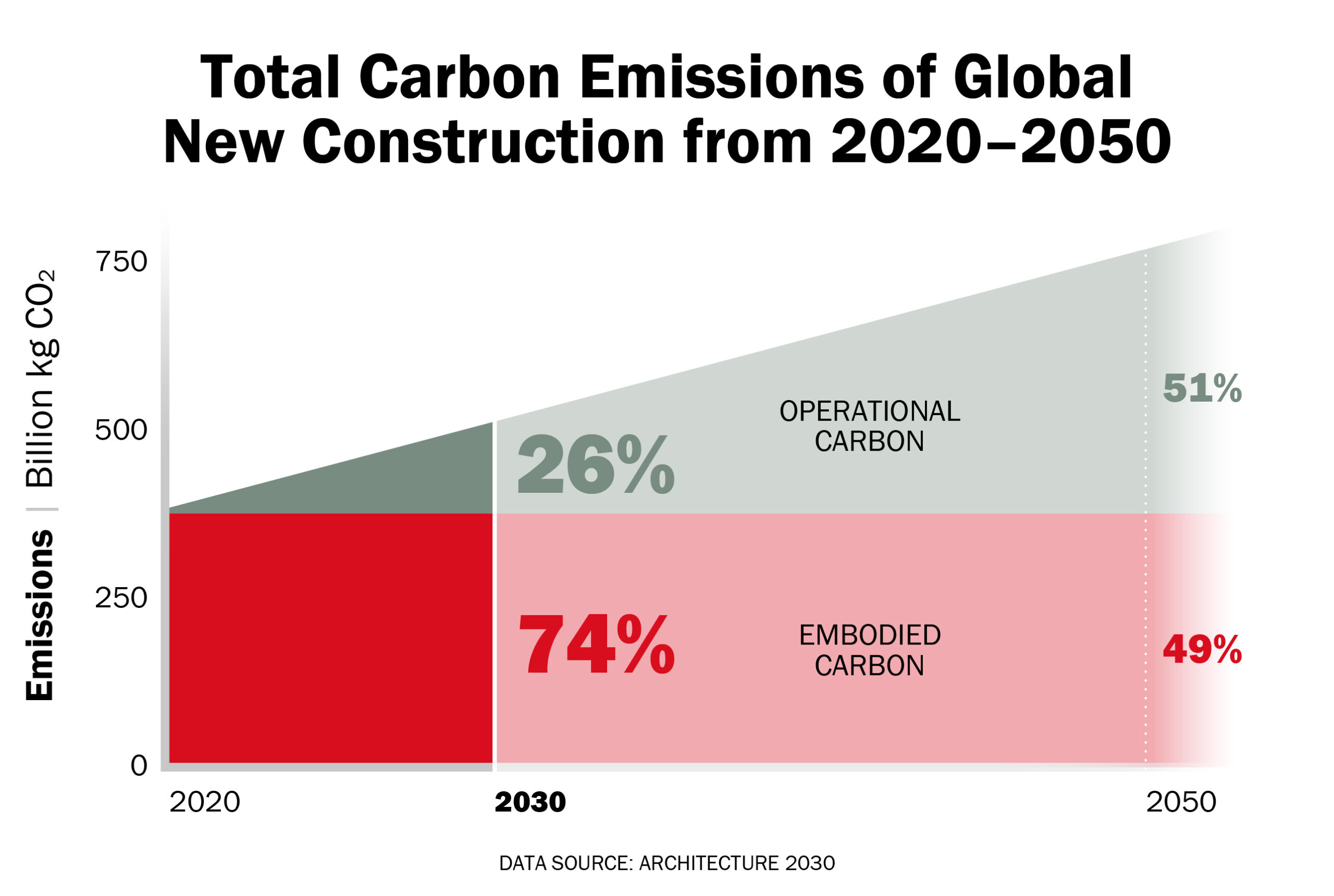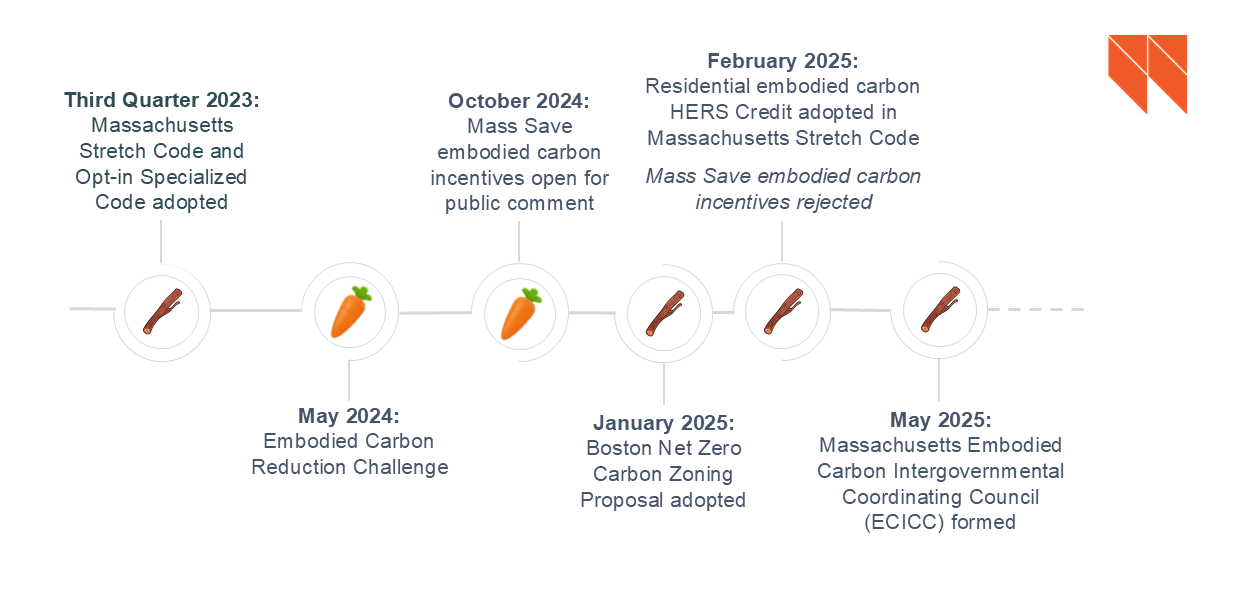

Blog
As the urgency to address the adverse effects of climate change intensifies, Massachusetts introduces more embodied carbon measures for building developers.

Embodied carbon is the greenhouse gas (GHG) emissions generated during the early “life” of a material—the extraction, production, transportation, and installation process—which happens before a building consumes energy and emits operational carbon.
While energy efficiency improvements in building operations have been a key focus for reducing carbon emissions, the upfront emissions from materials like concrete, steel, glass, and insulation are a significant contributor to the carbon footprint of a building.

In the first 30 years of a building’s operational life, nearly 50% of its total carbon emissions are attributed to embodied carbon, according to data from Architecture 2030.
There is a lot of action in Massachusetts surrounding embodied carbon. In this blog post, we’re recapping the progress made so far, from code enforcement around embodied carbon (sticks), to incentives, educational resources, and financing opportunities (carrots).


Massachusetts Stretch Code—one of the most rigorous energy codes in the country—is adopted with the option for municipalities to opt-in to a specialized, more stringent code.
The Stretch Code adopts the 2021 IECC with some additional amendments. It primarily focuses on operational carbon, with additional mandatory provisions such as EV charging infrastructure. The Stretch Code is an opt-in code municipalities can choose to adopt. As of April 8, 2025, 300 out of 351 municipalities have adopted the Stretch Code. (Source: MA DOER)

Massachusetts Clean Energy Center (MassCEC), with the support of Built Environment Plus (BE+), holds the first Embodied Carbon Reduction Challenge as an educational initiative to promote whole building Life Cycle Analysis (LCA).
Project teams showed how—and how much—carbon was reduced up front. About $400,000 in cash prizes were awarded to 11 lead case studies. Read about the submissions and winners.
The program served as a successful tool to build awareness and capacity around embodied carbon strategies. Many educational resources were made available on how to complete a whole building LCA including a very active online forum where ideas and challenges were exchanged between submitting project teams.
View SWA’s case study, Northland Newton Development, Building 7.

Mass Save proposes incentives for embodied carbon in the 2025–2027 Energy Efficiency and Decarbonization Plan and releases the proposal for public comment.
The proposed funding aimed to cover costs for conducting Global Warming Potential (GWP) calculations for single-family and multifamily dwelling units and encouraged building reuse. One incentive would have provided $10,000 for projects demonstrating 75% structural and enclosure reuse.
Ultimately, the incentives were deemed to be premature for inclusion in the three-year plan and were ultimately rejected in February 2025.
However, an Embodied Carbon Intergovernmental Coordinating Council was voted into effect, which began seeking nominations in December.
Since these incentives did not make it into the 2025-2027 plan, future embodied carbon funding may be significantly delayed.

The City of Boston adopts the Net Zero Carbon Zoning Initiative requiring embodied carbon accounting in newly constructed buildings as it aims to achieve carbon neutrality by 2050.
Originally proposed in summer 2024 and initially rejected, the Net Zero Carbon Zoning Proposal put forth by the City of Boston’s Planning Department and the Mayor’s Office of Housing was successfully adopted in January 2025.
The proposal accelerates the emissions limits set by Boston’s Building Emissions Reduction and Disclosure Ordinance (BERDO) for certain types of buildings. Starting July 1, 2025, new large projects (15 units or more, a minimum of 20,000 SF, and additions of a minimum of 50,000 SF or more to existing buildings) will be required to have net zero operational emissions when they open, instead of the gradual taper down specified in BERDO. Some building use types like hospitals, manufacturing, and labs will still have a phased in compliance to BERDO, albeit accelerated from the original plan.
Both small and large projects will be required to report on embodied carbon, and projects with a gross floor area (GFA) over 50,000 SF will have to conduct a building LCA. This will help the city gather data to develop a standardized approach to reporting embodied carbon emissions from buildings.
The Net Zero Carbon Zoning Proposal Summary is available to download from bostonplans.org.

A three-point HERS credit is added to the Stretch Code for projects meeting aggressive embodied carbon reduction targets for either insulation or concrete.
Currently, there is a focus on residential code updates affecting multifamily buildings of three stories or fewer and single-family homes following the HERS (Home Energy Rating System) pathway.

The new embodied carbon credit introduces an optional three-point HERS add-on under subsection R406.5.2 of the Stretch Code. This credit helps projects struggling to meet strict HERS requirements and can be achieved by addressing either insulation or concrete impacts.
The insulation credit is modeled after Vermont’s approach, requiring proof that all insulation in the building has a net GWP intensity less than or equal to zero and encouraging use of bio-based products.
The concrete credit requires that at least 90% of the project’s concrete demonstrates a calculated GWP less than or equal to 100% of the 2022 National Ready Mixed Concrete Association (NRMCA) Northeast benchmark. This benchmark was relaxed compared to the original, more stringent proposal, making compliance more achievable.
| Clean Energy Application | HERS Target | HERS Target with R406.5.2 EC Credit |
| Mixed Fuel Building | 42 | 45 |
| All-Electric Building | 45 | 48 |

The state of Massachusetts forms the Embodied Carbon Intergovernmental Coordinating Council (ECICC) dedicated to making recommendations for low-carbon building materials.
The ECICC is comprised of state government agency representatives and building construction experts. By January 1, 2026, the group will produce a plan to measure, monitor, and reduce embodied carbon in commonly used building materials, including cement and concrete mixtures, steel, glass, asphalt and asphalt mixtures, and wood.
The Net Zero Carbon Zoning proposal mandating whole building LCA along with many other municipalities is causing a ripple effect within Massachusetts.
For instance, Cambridge requires non-residential developments over 50,000 square feet to submit a whole building LCA.
Similarly, Green Newton requires new multifamily projects over 20,000 square feet to have embodied carbon reduction plans as well as projects over 50,000 square feet to meet the LEED Material and Resources Building Life-Cycle Impact Reduction credit and demonstrate at least a 10% reduction in embodied carbon relative to standard design and construction practices.
Incorporating the Embodied Carbon credit within the HERS pathway of the Mass Stretch Code will act as a template for many other states.
Embodied carbon will continue to pave its way into codes and incentives within Massachusetts, and will pave the way for other states and regions to make a lasting impact on the built environment and the fight against climate change.
Meanwhile, the latest version of LEED—LEED v5—launched in April and brings new embodied carbon requirements to the global program. Quantifying the impacts of structure, enclosure, and hardscape materials, as well as documenting cradle-to-gate emissions, will be required for all projects moving forward. Read our blog post on LEED v5 and embodied carbon.
If you’re involved in these conversations or have partners asking about these programs, now is the time to connect and align your strategies. Together, we can drive forward a future where reducing embodied carbon is a standard practice in building design and construction.
SWA’s sustainability consultants working in Boston and across Massachusetts stay up to date on both embodied and operational carbon rules, regulations, and incentives. Contact us to collaborate on your next project.
Contributors: Kai Starn, Senior Sustainability Consultant; Shari Rauls, Sustainability Consultant; Karla Butterfield, Sustainability Director
Steven Winter Associates